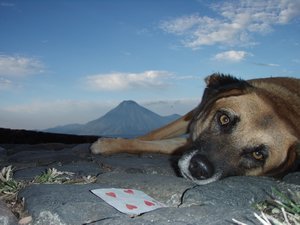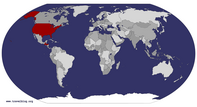Advertisement
Published: November 6th 2009

 Dog Near the Toxic Lake
Dog Near the Toxic Lake
In case you are worried, this dog is not dead and he is quite friendly. He is also quite lazy, for he lied here while I took this photo of him. He is lying in front of the lake; in the far background you can see San Pedro Volcano on the other side of the lake.The Death of Lake Atitlan
I recently watched the new Star Trek movie; in this movie, a young Dr. Spock watches as his planet is completely destroyed. But this theme of planets being completely destroyed is not new to Star Trek (or Star Wars); no, this is a reoccurring theme in many of the series’ episodes. One species of beings decides that it wants to completely destroy the planet and home of another species.
As a kid, I enjoyed watching Star Trek and felt challenged by its themes. In one episode of “Star Trek: The Next Generation” Capitan Picard discovers the one weakness of an almost all-powerful race of beings whose only objective and mission is to destroy through assimilation all other beings in the universe. Through his knowledge of this one weakness, Picard has to decide whether or not to completely destroy this race of beings. I probably first watched this episode before I learned the word “genocide,” but the ethical dilemma was clear—is genocide okay when it is being used to kill off a group intent on committing genocide themselves? Capitan Picard decided that even under this circumstance, genocide was wrong.
It wasn’t until university that
I actually studied science fiction. I took a course in science fiction literature while in London to fulfill some divisional requirements for graduation. It was in this class that I was told that science fiction isn’t about the future. Science fiction is about the present. It is about looking at what is happening in the world today and hypothesizing about what will happen if we keep doing the same thing. Much of science fiction is about how humans will destroy themselves and the world in the quest to make life better (or easier).
But it is impossible for us to watch, from outer space, a verdant planet occupied by sentient beings change into a dead black sphere as we can on an episode of Star Trek. But this is what I feel like I have just witnesses. I feel like I have just witnesses an entire thriving ecosystem destroyed almost overnight.
If you are an avid reader of my blog, you have probably read some of my entries from last year: “Moto Adventures on Lago de Atitlan”, “Map-Quest with Elmer”, or “Drugs, Ex-pats, and Evangelists”. All these articles detail the beauty and unique culture of the area surrounding

 Field
Field
Here you can see some of the beautiful fields that drain their fertilizers into the lakeLake Atitlan. A little over a month ago, I returned to Lake Atitlan. You may have looked at pictures of me diving off of a cliff into the lake in my entry entitled: “My New Best Friend”. I usually don’t cliff dive—it is dangerous. In open bodies of water, you should always go in feet first. But Lake Atitlan is different, the waters are so clear that I could see the bottom. I could see that the water was deep enough.
But that was a month ago. This lake with crystal clear waters is now covered with algae called cyano-bacteria. I just returned to Lake Atitlan a few days ago to show my family the place that I considered one of the most beautiful and relaxing in the world, and we were greeted by the stench of cancerous algae. We stayed in San Pedro’s most expensive hotel. It is lakeside with a terrace restaurant which looks out over the lake and surrounding volcanoes. But now, there is a view of a bog of algae, and the putrid smell that accompanies it. I took my family to my favorite restaurant, La Puerta, where you can sit out on a lawn

 The Clear Waters of Atitlan
The Clear Waters of Atitlan
This is Atitlan a month agounder thatched roofed huts and drink chai tea or strawberry smoothies while eating what they call a tropical burrito. A month ago Caitlin and Ingvild were drinking their morning tea here while I was out kayaking. I saw them and rowed up to shore. I stepped out into the shallows of the crystal clear water, walked to shore, bid them good morning, sampled their tea, and then rowed back out into the serene waters. But now, sitting here with my family, all we can see is greenish-brown muck. If this were in my toilet, I would flush twice to make sure the bowl was clean. But this is not a toilet bowl with lever that can be pushed so that this waste goes somewhere else and becomes a problem elsewhere. But the metaphor of a toilet is not completely wrong. This lake has been used for many purposes for many years.
The locals fish from the lake, and fish that are not indigenous to the lake have been introduced and have, from what I have heard, taken over. The locals bathe in this lake. The locals wash their clothes in this lake with inorganic soaps. They fertilize their fields—fields

 Diving into the lake
Diving into the lake
This was a month ago when the water was clean.which sit on the sides of the surrounding volcanoes and drain into the lake. And the pueblos, some of them boasting giant hotels for tourists like myself, lack sewage processing plants and thus release all the wastes of the pueblos into the lake. Guatemala is a small country on an isthmus between the Atlantic and Pacific; there must be a stream draining this water out into the ocean—passing this toxic water on to the fish in the sea and sparing Lake Atitlan of its death. But alas, Atitlan, in reality is no toilet. There is not release valve. There is not flush lever. All streams flow into the Lake. Lake Atitlan is a closed body of water and this problem is trapped here.
So does this story have a happy ending? There are glimmers of hope, but probably, no. The community has been stirred to action. Specialists from the United States have been studying the water. The Vice President of Guatemala has been commenting on the state of the lake daily. The Government is trying to appropriate funds to create 15 waste processing plants and build public wash sinks in every community to keep people from washing clothes in

 La Puerta Then
La Puerta Then
This is Ingvild, a month ago, sitting on the shore of the lake at the restaurant La Puerta. I am sure she would not sit there now.the lake.
But the most amazing, the most spectacular, and the saddest, is the community out cleaning the lake. This lake is over ten miles across; it has a surface area of over 80 square miles. And the algae, as far as I could see during my trip across the lake, completely covers the lake. It is heartening to see a group of people band together to clean their environment, a community mobilized to action for a common good, but it seems impossible that 20 people here and 20 people there with strainers and sheets being used as strainers can have an effect on this lake. My family and I watched from our rooftop terrace as a group of people cleaned the tiny cove that sits in front of our hotel. Twenty people spent half the day cleaning, and by the evening there was a pile of muck on the shore, and an area the size of a large swimming pool was quite clean of surface algae. However, this small area was nowhere close to 80 square miles, and the next morning, the cove was covered again in algae. Even sadder is the potential toxicity of this water. While

 La Puerta Now
La Puerta Now
This is my family having a meal a La Puerta. Notice we do not have the lake in the background of this picture--it is much too ugly from this close.preliminary results indicate that the algae is not poisonous to people, alarm is still raised and more tests are in process. But the mayor of one town told the people to go out and clean the lake and out they went.
While the death of this lake is not certain, and I am not clairvoyant, very little hope seems to exist for this lake. It is a closed body of water meaning the food that this algae is feeding on will not be flushed out. The farmers surrounding the lake will continue to fertilize their fields and from what I understand, even organic fertilizers will feed the algae. The towns may build treatment plants, but the pollution already exists in the water and it may take a long while before the waste-water treatment plants can be completed.
As a child I watched a planet turn black on the show Star Trek as the crew on the starship lamented the loss of an entire civilization. Now as an adult, I have seen the waters of life for many village communities change from sparkling clear to a brownish-green. A blanket of filth so pervasive that I fear it could block

 People cleaning the lake
People cleaning the lake
The villagers cleaned this area of the lake. It took them half a day. The next day all the algae was back. I wonder how many of them became sick due to their contact with this substanceout all the light that penetrates down to the plants and fish that live below and could use up the oxygen necessary for the life as well. This is not science fiction, no there is nothing fictional about this. I feel as if I have watched this lake die.
The solution being tossed around right now is solving this problem with chemicals. The Vice President is talking about using a chemical to kill the algae. But I wonder, wasn’t it chemicals which caused this problem in the first place?
Advertisement
Tot: 0.092s; Tpl: 0.015s; cc: 11; qc: 50; dbt: 0.0485s; 1; m:domysql w:travelblog (10.17.0.13); sld: 1;
; mem: 1.2mb











MOM
non-member comment
Hard to read but very well done!
Hi Phil. You have done a great job of presenting the problem that you have witnessed first-hand! It is, however, very hard to read because of the sadness that the story causes. I have been grieving the seeming "death" of this beautiful lake ever since I first became aware of the problem last week while visiting it with you. Thanks again for the grand time we had with you in Guatemala!! Love you lots, MOM